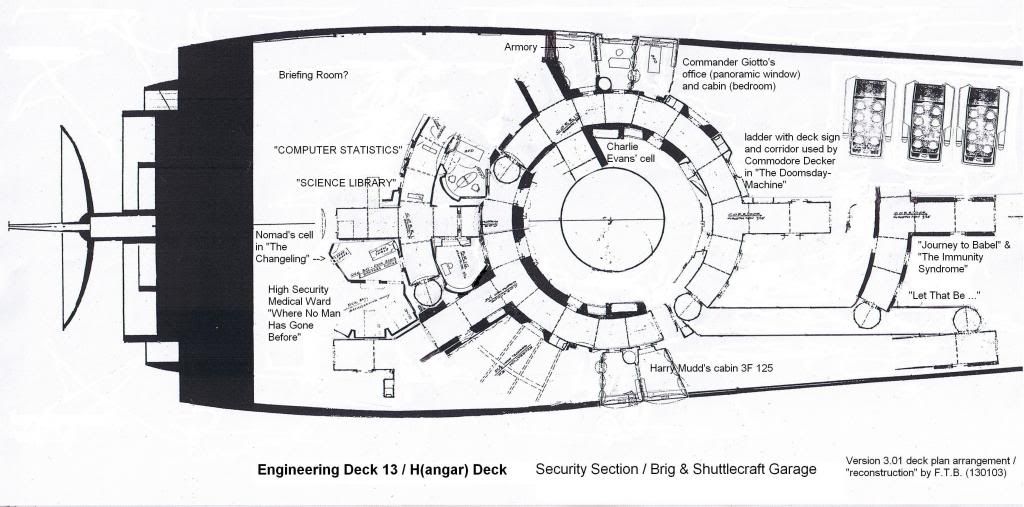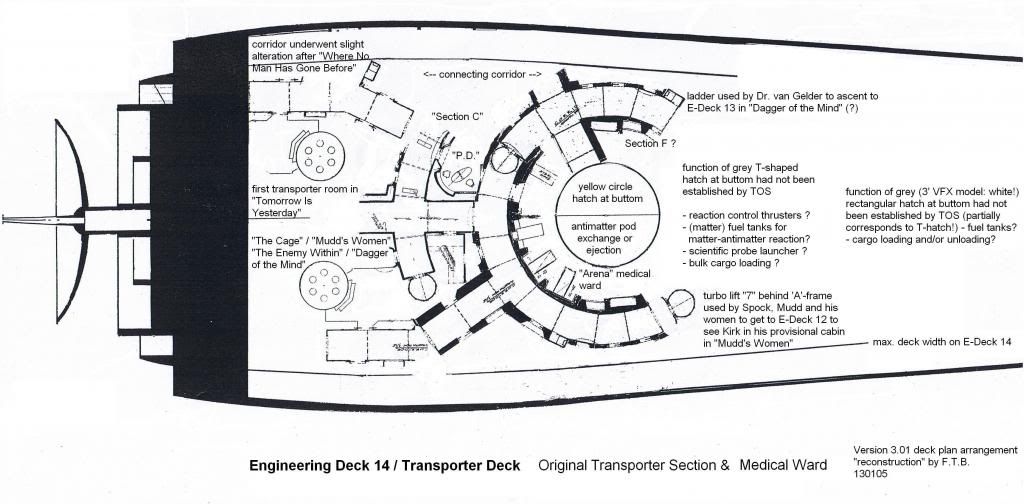Thanks Mytran, again. Here is the
Engineering Deck 12 commentary
Part II:
Before I get to the EPS relay chamber now relocated on E-Deck 12, I’d like to take a deeper look at the
Enterprise’s matter-antimatter reactors,
but you may of course feel free to fast forward to the bottom.  Three matter-antimatter reactors aboard USS Enterprise according to TOS
Three matter-antimatter reactors aboard USS Enterprise according to TOS
According to blssdwlf’s exemplary
extrapolation and according to “Catspaw” the
Enterprise apparently has three M-AM reactors, one in each of the warp nacelles and one in the engineering hull, which is probably “reactor number three” where Spock located the alien entity in “Day of the Dove”.
The strongest evidence for this third M-AM reactor (i.e. one that's not part of the nacelles) came from “That Which Survives”:
“Watkins must've been murdered. I sent him in to check the matter-antimatter reactor.” (Scotty)
In this episode the A.I. Losira sabotages the reactor controls, thus antimatter from the antimatter pod streams into the reactor and apparently the fail-safe mechanisms of the
Enterprise automatically inject matter into the reactor. This results in an overabundant output of warp drive energy channeled to the nacelles, which needs to be stopped before the overload is tearing the nacelles and the ship apart:
“It's a power surge. I'm working on it. Reduce speed until I locate the trouble.” ... “The engines are running wild. There's no way to get at them. We should reach maximum overload in about fifteen minutes.” (Scotty)
One option is to jettison the “(antimatter) pod” to stop the antimatter input and apparently the service crawlway with Scotty would be jettisoned as well:
“Please do not take your eyes off of it. Lieutenant Rahda, arm the pod jettison system.” (Spock)
“Aye, sir. I'll jettison the pod at the first sign of trouble.” (Lt. Rahda)
As we learned earlier in this episode the crawlway is close to the matter-antimatter reactor:
“As I recall the pattern of our fuel flow, there is an access tube leading to the matter-antimatter reaction chamber.” (Spock)
”There's a service crawlway, but it's not meant to be used while the integrator operates.” (Scotty)
Fortunately Spock only “recalls”, i.e. (vaguely) remembers that the access tube leads to the reaction chamber, but apparently that isn’t the case: Only Scotty in the crawlway and the antimatter pod would have been jettisoned, not necessarily the entire reactor (though I have no doubt that were possible, should containment of the reactor chamber ever fail).
I further believe this antimatter pod to be a unique design addition (Lawrence Marvick?) to the 17th cruiser design like the Enterprise and her sister ships, as the USS Constellation (“The Doomsday-Machine”) probably didn’t have (yet) such an extra antimatter pod:
“We made a complete check on structural and control damage, sir. As far as we can tell, something crashed through the deflectors and knocked out the generators. Somehow the antimatter in the warp drive pods has been deactivated.” (Washburn)
Obviously Washburn refers to the antimatter pods in the nacelles
or the antimatter stored in the warp drive “pods” (nacelles).
If there
were a third antimatter pod in the Constellation’s engineering hull, it would be odd that he failed to report its condition (equally rendered inert?).
Alternately there may have been a reactor inside the Constellation that drew
exclusively antimatter from the nacelles, but – of course – couldn’t be put to use because its fuel had been “deactivated”. In the light of Scotty’s first assessment (
nacelle caps gone, warp engine function theoretically possible, condition of antimatter unknown) this appears to be the case.
The enigmatic “energizers” – energize what?
I’m currently (only) aware of two circumstances where the Enterprise’s “energizers” were knocked out during a space battle
and explicitly mentioned as such:
1. Khan’s sneak attack on Spock’s Enterprise in TWOK apparently targeted these important components (Scotty: “Main energizers out!”) and thus deprived the Enterprise of her warp and shield power.
2. Previously, the TOS Enterprise’s energizers were knocked out during the battle with the planet killer in “The Doomsday Machine”:
"Sir, deflector shields are gone." (Spock to Decker)
Palmer to Spock:
"Sir, Deck seven reports power failure in main energizers. Implementing emergency procedures. Severe casualties reported on decks three and four. Damage control party sealing off inner hull rupture."
Spock:
"It has ceased fire. We're being held in a tractor beam. We're being pulled inside, Commodore. You must veer off."
Decker:
"Maintain phaser fire, helmsman."
Spock:
"We have lost warp power. If we don't break the tractor beam within sixty seconds, we never will."
Apparently the main energizers are located in or near Deck 7 (Engineering Control Room on Main Deck 7
or E-Deck 7, provided that Main Deck 7 already has a nickname?), their failure subsequently resulted in the loss of the deflector shields and warp power and instant phaser energy (opposite to slowly “charging” the phaser banks).
IMHO, the energizers' failure let to a momentarily shutdown of one or all of the matter-antimatter reactors as it is their energy output that enables deflector shields, warp power and instant phaser fire (though, oddly, in “Elaan of Troyius” the dilithium crystal converter assembly had been sabotaged and no phaser energy at all was available but power for the deflectors

).
The energizers therefore play an important role in the ship’s power infrastructure, but which one exactly?
The term “energizer” itself is rather general and vague and the TOS scriptwriters were most definitely not inspired by our famous Energizer Batteries, because this brand name was not established before 1980 (of course, we can’t exclude the possibility that Energizer Holdings will continue to flourish until the 23rd Century by which time “energizer” has become the colloquial term for any kind of battery - especially since according to “Mudd’s Women” it’s possible to “energize” in the transporter room by means of the ship’s reserve and battery power).

Looking for an analogy we all know that battery power is essential to start the combustion engine in our automobiles and it could appear that the “energizers” aboard a starship essentially perform the same function. As to their appearance I assume these to look like these giant GNDN (“Goes Nowhere, Does Nothing”) props we’ve seen so often and differently aligned in the
TOS engine rooms. I’d like to believe these to be fusion reactors and a
cut scene from “The Enemy Within” (Contributors Part 1) shows two engineering crewmen with portable radiation counters – something you’d expect to see in the vicinity of reactors.
Some time ago I mentioned that I believe those wall elements seen in “In A Mirror, Darkly” to be TOS next generation (i.e.
Defiant style) energizers. In the new draft of E-Deck 12 these not only provide “battery power” to the transporters (on E-Deck 14 if necessary) but also heat up the antimatter (You can’t mix matter and antimatter cold according to Scotty in “The Naked Time”) and help start the matter-antimatter reactors aboard a starship and continue to assist the matter-antimatter reactor/s during operation.
While the (old TOS style) EPS relay chamber aboard the Enterprise would look somewhat differently, the
screencap from the ENT episode “In A Mirror, Darkly” conveys the basic idea: The energizers / fusion reactors seen here channel the fusion plasma into distribution conduits on the floor (apparently with some noticeable and typical blue
Cherenkov radiation glow we usually notice in offline warp plasma conduits like
“The Tholian Web”
The “Primary EPS relays” seem to function as fuses or spark plugs to “ignite” the matter-antimatter reactor and spur it into action. The events depicted in this ENT episode seem to support the theory:
Plugged back into their assembly sockets the primary EPS relays immediately enabled the
USS Defiant to raise deflector shields and to instantly open phaser fire at the mirror universe
USS Avenger.
Although I’m not a friend of retcon maneuvers, this particular one did help me to understand a possible working principle that previously had remained largely unaddressed, IMHO.
Please feel free to add comments or issues I may have overlooked.
Bob

 ).
). ).
). . Please accept my apologies!
. Please accept my apologies!








